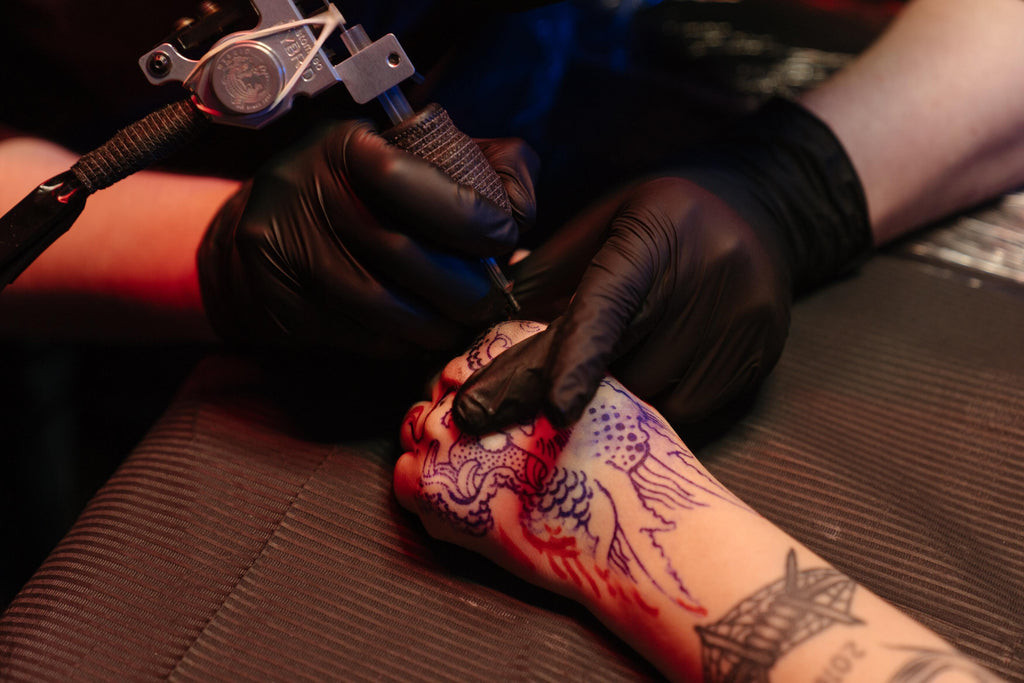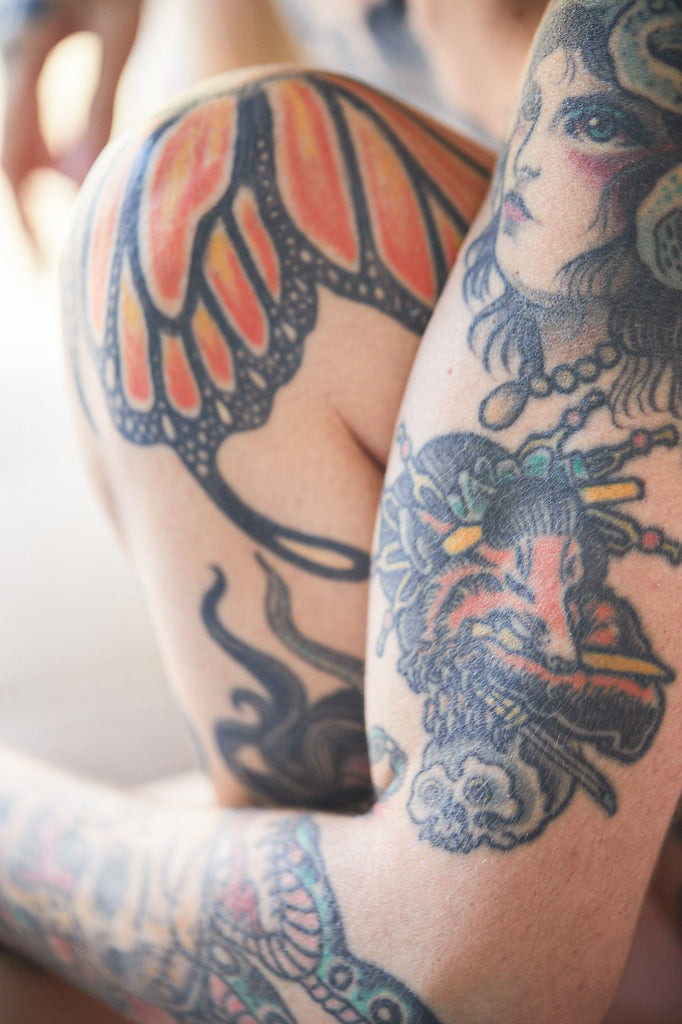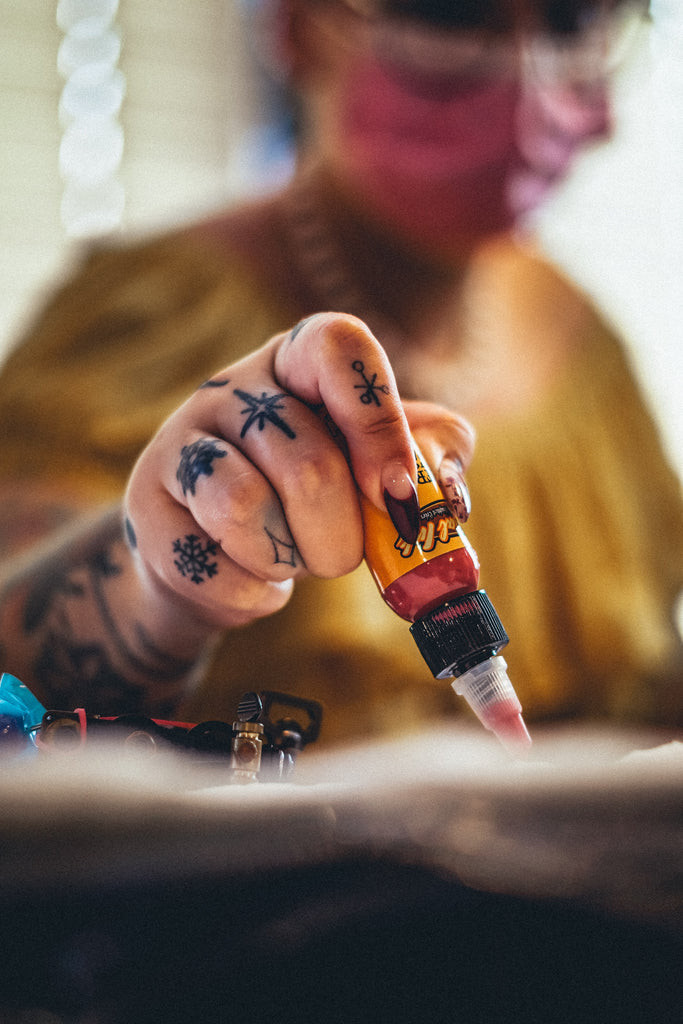Is your old tattoo feeling raised, and you’re wondering why? This sensation, where the inked lines of your tattoo become elevated, is a common concern among tattoo enthusiasts, and tattooat.com is here to provide clarity. Understanding the reasons behind this phenomenon, from initial swelling to allergic reactions, will help you ensure your body art remains a source of pride, offering solutions to keep your skin smooth and your tattoos vibrant. Dive into the world of tattoo aftercare, skin sensitivity, and the artistry of body modification with us.
1. Is It Normal for My Old Tattoo to Feel Raised?
Yes, it’s often normal for an old tattoo to occasionally feel raised. Fluctuations in body temperature, seasonal changes, or even minor skin irritations can cause the tattooed area to swell slightly, making the ink feel more prominent. However, persistent or worsening elevation could indicate other underlying issues that warrant attention.
Why Does This Happen?
Several factors can contribute to the sensation of a raised tattoo. These include:
- Scar Tissue Formation: The tattooing process inherently involves creating tiny punctures in the skin, which can sometimes lead to the formation of scar tissue. According to research from Portland State University’s Art Department, in July 2025, thicker lines and heavier pressure during the tattooing process are more likely to result in noticeable scar tissue, which may feel raised to the touch.
- Environmental Factors: Changes in temperature and humidity can affect the skin’s hydration levels and cause it to swell or contract, which can make the tattoo lines feel more raised.
- Allergic Reactions: Although rare, a delayed allergic reaction to the tattoo ink can cause inflammation and swelling, resulting in a raised sensation.
 A close-up of a healed tattoo on an arm, showcasing the intricate linework and shading, with a slight raised texture.
A close-up of a healed tattoo on an arm, showcasing the intricate linework and shading, with a slight raised texture.
When Should You Be Concerned?
While occasional and mild elevation is usually harmless, it’s essential to monitor your tattoo for any signs of complications. Consult a dermatologist or your tattoo artist if you experience any of the following:
- Excessive redness or warmth around the tattoo
- Persistent itching or rash
- Drainage or pus from the tattooed area
- Fever or other signs of infection
2. What Are the Common Causes of a Raised Tattoo Years Later?
Several factors can contribute to a tattoo feeling raised years after it was initially inked. Scar tissue, allergic reactions, and environmental changes are the common causes of a raised tattoo years later. Let’s explore these causes in detail:
Scar Tissue
- The Body’s Natural Response: When you get a tattoo, the needles penetrate the skin, creating tiny wounds. As your body heals, it produces collagen to repair the damage. Sometimes, this healing process can lead to the formation of scar tissue, which is thicker and less flexible than normal skin.
- How Scar Tissue Affects Tattoos: Scar tissue can cause the tattoo to feel raised to the touch. According to Inked Magazine, tattoos with bold lines or heavy shading are more prone to raised scar tissue due to the increased trauma to the skin.
- Managing Scar Tissue: While you can’t eliminate scar tissue completely, you can minimize its appearance by keeping the area moisturized and avoiding excessive sun exposure. Topical treatments like silicone gels can also help flatten and soften scar tissue.
Allergic Reactions
- Delayed Hypersensitivity: In some cases, an allergic reaction to tattoo ink can occur years after the tattoo was initially done. This is known as delayed hypersensitivity, and it can manifest as raised, itchy bumps or a rash around the tattooed area.
- Common Culprits: Red and yellow tattoo inks are more likely to cause allergic reactions, as they often contain mercury sulfide and cadmium sulfide, respectively.
- Seeking Medical Attention: If you suspect an allergic reaction, consult a dermatologist for diagnosis and treatment. They may recommend topical corticosteroids or antihistamines to relieve itching and inflammation.
Environmental Factors
- Temperature Changes: Fluctuations in temperature can affect the skin’s hydration levels, causing it to swell or contract. This can make the tattoo lines feel more raised, especially during hot and humid weather.
- Dry Skin: In the winter months, dry skin can exacerbate the feeling of a raised tattoo. When the skin loses moisture, it becomes less pliable and can accentuate the underlying scar tissue or ink particles.
- Hydration is Key: Keeping your skin well-hydrated by drinking plenty of water and using a moisturizer can help minimize the effects of environmental factors on your tattoo.
 A person applying lotion to their tattooed arm, emphasizing the importance of moisturizing for tattoo aftercare and maintenance.
A person applying lotion to their tattooed arm, emphasizing the importance of moisturizing for tattoo aftercare and maintenance.
3. Can Weather Affect How My Old Tattoo Feels?
Yes, weather can significantly affect how your old tattoo feels. Temperature and humidity changes can cause the skin to expand or contract, which can make the tattoo feel raised or itchy.
Hot and Humid Weather
- Skin Swelling: According to a study by the American Academy of Dermatology, high humidity levels can cause the skin to absorb moisture from the air, leading to swelling. This swelling can make the tattoo ink feel more raised and prominent.
- Itchiness: Sweat can also irritate the skin and cause itchiness, especially if it gets trapped under clothing. The combination of swelling and itchiness can make your tattoo feel uncomfortable.
- Preventive Measures: To minimize the effects of hot and humid weather, wear loose-fitting clothing made of breathable fabrics like cotton. Keep the tattooed area clean and dry, and apply a light, non-comedogenic moisturizer to help keep the skin hydrated.
Cold and Dry Weather
- Skin Contraction: Cold, dry air can strip the skin of its natural oils, causing it to become dry and tight. This contraction can make the tattoo lines feel more raised and accentuated.
- Cracking and Flaking: Dry skin is also more prone to cracking and flaking, which can further irritate the tattooed area.
- Intensive Moisturizing: Combat the effects of cold, dry weather by using a rich, emollient moisturizer several times a day. Look for products containing ingredients like shea butter, cocoa butter, or hyaluronic acid to help lock in moisture and protect the skin.
4. Is My Raised Tattoo a Sign of a Tattoo Infection or Allergic Reaction?
A raised tattoo can be a sign of either a tattoo infection or an allergic reaction, but it is essential to distinguish between the two. Infections and allergic reactions share some symptoms, but they require different treatments.
Tattoo Infection
-
Causes: Tattoo infections typically occur when bacteria enter the skin during or after the tattooing process. This can happen if the tattoo equipment is not properly sterilized, or if the tattoo is not cared for properly during the healing process.
-
Symptoms: In addition to a raised tattoo, symptoms of a tattoo infection may include:
- Redness
- Swelling
- Pain
- Pus or drainage
- Fever
- Chills
-
Treatment: If you suspect a tattoo infection, it’s crucial to seek medical attention immediately. Your doctor may prescribe antibiotics to clear the infection.
Allergic Reaction
-
Causes: Allergic reactions to tattoo ink are less common than infections, but they can still occur. These reactions are typically caused by the pigments in the ink, particularly red and yellow inks.
-
Symptoms: In addition to a raised tattoo, symptoms of an allergic reaction may include:
- Itching
- Rash
- Hives
- Blisters
-
Treatment: If you suspect an allergic reaction, consult a dermatologist. They may recommend topical corticosteroids or antihistamines to relieve itching and inflammation. In severe cases, they may prescribe oral medications or recommend laser tattoo removal.
 A close-up of an allergic reaction on a tattoo, highlighting the redness, raised bumps, and inflammation around the inked area.
A close-up of an allergic reaction on a tattoo, highlighting the redness, raised bumps, and inflammation around the inked area.
5. What Are the Best Ways to Treat a Raised Tattoo at Home?
If your tattoo feels raised, there are several ways to treat it at home. Gentle cleaning, moisturizing, and cold compresses are the best ways to treat a raised tattoo at home. However, seeking professional medical advice is essential if the symptoms worsen.
Gentle Cleaning
- Why It Helps: Keeping the tattooed area clean helps prevent infection and irritation.
- How to Do It: Wash the tattoo with mild, fragrance-free soap and warm water. Gently pat it dry with a clean towel.
- Frequency: Clean the tattoo 1-2 times a day, especially if you’ve been sweating or exposed to dirt and debris.
Moisturizing
- Why It Helps: Moisturizing keeps the skin hydrated and prevents dryness, which can exacerbate the feeling of a raised tattoo.
- How to Do It: Apply a thin layer of fragrance-free, hypoallergenic moisturizer to the tattooed area.
- Frequency: Moisturize the tattoo several times a day, especially after cleaning it.
Cold Compresses
- Why It Helps: Cold compresses can help reduce swelling and inflammation.
- How to Do It: Wrap a few ice cubes in a clean towel and apply it to the tattooed area for 10-15 minutes at a time.
- Frequency: Apply cold compresses several times a day as needed.
Additional Tips
- Avoid Scratching: Scratching can further irritate the skin and increase the risk of infection.
- Wear Loose Clothing: Tight clothing can rub against the tattoo and cause irritation.
- Protect from the Sun: Sun exposure can damage the skin and make the tattoo feel more raised. Apply sunscreen with an SPF of 30 or higher to the tattooed area whenever you go outside.
6. How Can I Tell If My Raised Tattoo Is Due to Scar Tissue?
Determining whether a raised tattoo is due to scar tissue involves careful observation and understanding of your skin’s healing process. Visual inspection, palpation, and considering the tattoo’s history are key to identifying scar tissue.
Visual Inspection
- Look for Texture Differences: Scar tissue often appears as a raised, thickened area of skin that may have a different texture than the surrounding skin. It may be smoother or more rigid.
- Check for Shiny or Discolored Areas: Scars can sometimes appear shiny or have a different color than the surrounding skin. They may be lighter or darker in pigment.
- Observe the Tattoo’s Lines: If the raised areas correspond to the tattoo’s lines, particularly in areas with bold lines or heavy shading, it’s more likely to be scar tissue.
Palpation (Touch)
- Feel for Firmness: Gently feel the tattooed area with your fingertips. Scar tissue typically feels firm and less pliable than normal skin.
- Assess Elevation: Scar tissue is often raised above the surrounding skin. Run your fingers across the tattooed area to feel for any noticeable elevation.
- Check for Sensitivity: Scar tissue may be more sensitive to touch than normal skin. Gently press on the raised areas to see if they are tender or painful.
Consider the Tattoo’s History
- Think About the Tattooing Process: Tattoos that involved heavy pressure or multiple passes with the needle are more likely to result in scar tissue.
- Reflect on Healing: If the tattoo took a long time to heal or was prone to inflammation, it’s more likely to have scar tissue.
- Note Any Previous Irritation: Repeated irritation or infection of the tattooed area can also contribute to scar tissue formation.
7. What Role Does Tattoo Ink Play in Raised Tattoos?
Tattoo ink plays a significant role in raised tattoos, as the body’s reaction to the ink’s composition and the tattooing process can lead to inflammation and scar tissue. Ink composition, depth of ink placement, and allergic reactions all contribute to the phenomenon of raised tattoos.
Ink Composition
- Pigment Type: Tattoo inks contain various pigments to create different colors. Some pigments are more likely to cause allergic reactions or inflammation than others. According to a study published in the Journal of the American Academy of Dermatology, red and yellow inks are more frequently associated with allergic reactions due to the presence of mercury sulfide and cadmium sulfide, respectively.
- Heavy Metals: Some tattoo inks contain heavy metals like nickel, chromium, and cobalt, which can also trigger allergic reactions or skin irritation.
- Quality of Ink: The quality of tattoo ink can also affect the likelihood of a raised tattoo. Low-quality inks may contain impurities or irritants that can cause inflammation.
Depth of Ink Placement
- Proper Depth: Tattoo ink should be placed in the dermis, the layer of skin beneath the epidermis. If the ink is placed too shallow, it can cause the tattoo to fade or blur. If it’s placed too deep, it can cause scarring and a raised appearance.
- Scar Tissue Formation: When the ink is placed too deep, it can damage the skin and lead to the formation of scar tissue, which can make the tattoo feel raised.
- Artist’s Skill: The skill and experience of the tattoo artist play a crucial role in ensuring proper ink placement. An experienced artist will know how to adjust the depth and pressure of the needle to minimize trauma to the skin.
Allergic Reactions
- Immediate Reactions: Some people may experience an immediate allergic reaction to tattoo ink, which can cause redness, swelling, and itching.
- Delayed Reactions: In other cases, allergic reactions may not appear until months or even years after the tattoo was done. These delayed reactions can manifest as raised, itchy bumps or a rash around the tattooed area.
- Patch Testing: If you have sensitive skin or a history of allergies, consider getting a patch test before getting a tattoo. A patch test involves applying a small amount of tattoo ink to your skin to see if you have a reaction.
8. When Should I See a Doctor About My Raised Tattoo?
Knowing when to seek professional medical advice for a raised tattoo is crucial to prevent complications and ensure proper care. Persistent symptoms, signs of infection, and allergic reactions warrant a visit to the doctor.
Persistent Symptoms
- Unexplained Elevation: If your tattoo remains raised for an extended period without any apparent cause, it’s essential to consult a doctor. Prolonged elevation could indicate an underlying issue that needs to be addressed.
- Increasing Pain or Discomfort: If you experience increasing pain, tenderness, or discomfort in the tattooed area, it’s a sign that something is not right. Seek medical attention to determine the cause and receive appropriate treatment.
- Spreading Inflammation: If the inflammation around your tattoo is spreading or worsening, it could indicate an infection or allergic reaction that requires medical intervention.
Signs of Infection
- Pus or Drainage: The presence of pus or drainage from the tattooed area is a clear sign of infection. Seek medical attention immediately to prevent the infection from spreading.
- Fever or Chills: If you develop a fever or chills in conjunction with a raised tattoo, it could indicate a systemic infection. Seek medical attention without delay.
- Red Streaks: Red streaks radiating from the tattoo can indicate a spreading infection. Seek medical attention promptly.
Allergic Reactions
- Severe Itching: Intense itching that doesn’t respond to over-the-counter remedies could be a sign of an allergic reaction. Consult a dermatologist for diagnosis and treatment.
- Hives or Blisters: The appearance of hives or blisters around the tattoo can indicate an allergic reaction. Seek medical attention to determine the cause and receive appropriate treatment.
- Difficulty Breathing: In rare cases, severe allergic reactions to tattoo ink can cause difficulty breathing. Seek emergency medical attention immediately.
9. Are There Certain Tattoo Styles More Prone to Feeling Raised?
Yes, certain tattoo styles are more prone to feeling raised due to the techniques used and the amount of ink deposited into the skin. Bold lines, heavy shading, and scarification-like techniques can contribute to a raised tattoo.
Bold Lines and Outlines
- Increased Trauma: Tattoos with bold lines and outlines often require multiple passes with the needle to achieve the desired thickness and definition. This can cause increased trauma to the skin, leading to inflammation and scar tissue formation.
- Higher Ink Volume: Bold lines also require a higher volume of ink to be deposited into the skin, which can further contribute to inflammation and a raised appearance.
- Healing Process: Tattoos with bold lines may take longer to heal than those with finer lines, increasing the risk of complications like infection or excessive scarring.
Heavy Shading and Solid Color
- Extensive Coverage: Tattoos with heavy shading or solid color involve covering large areas of skin with ink. This can cause significant trauma and inflammation.
- Potential for Uneven Healing: The healing process for heavily shaded tattoos can be uneven, leading to areas of raised skin or scar tissue.
- Ink Density: The high density of ink in these tattoos can also make them more prone to feeling raised, especially in areas where the ink is concentrated.
Scarification-Like Techniques
- Intentional Scarring: Some tattoo styles, such as scarification or tribal tattoos, intentionally create raised scars as part of the design.
- Permanent Elevation: These tattoos are meant to be permanently raised and textured, giving them a unique look and feel.
- Specialized Techniques: Achieving this effect requires specialized techniques and a skilled artist who understands how to manipulate the skin to create raised scars.
10. What Long-Term Care Tips Can Prevent My Tattoo From Feeling Raised?
Preventing your tattoo from feeling raised long-term involves consistent skincare, sun protection, and prompt attention to any signs of irritation or inflammation. Proper hydration, gentle exfoliation, and avoiding harsh chemicals are essential for maintaining smooth, healthy skin around your tattoo.
Consistent Skincare Routine
- Daily Cleansing: Cleanse the tattooed area daily with a mild, fragrance-free soap to remove dirt, sweat, and bacteria. Avoid harsh soaps or scrubs that can irritate the skin.
- Regular Moisturizing: Apply a thin layer of fragrance-free, hypoallergenic moisturizer to the tattooed area after cleansing. This helps keep the skin hydrated and prevents dryness, which can exacerbate the feeling of a raised tattoo.
- Gentle Exfoliation: Exfoliate the tattooed area gently once or twice a week to remove dead skin cells and promote cell turnover. Use a soft washcloth or a gentle exfoliating scrub.
Sun Protection
- Sunscreen Application: Protect your tattoo from sun exposure by applying sunscreen with an SPF of 30 or higher whenever you go outside. Sunscreen helps prevent fading, discoloration, and skin damage.
- Protective Clothing: In addition to sunscreen, wear protective clothing like long sleeves or hats to shield your tattoo from the sun’s harmful rays.
- Avoid Tanning Beds: Tanning beds emit ultraviolet radiation that can damage the skin and cause tattoos to fade or become raised.
Prompt Attention to Irritation
- Monitor for Changes: Regularly inspect your tattoo for any signs of irritation, such as redness, swelling, itching, or bumps.
- Treat Minor Irritations: If you notice any minor irritations, treat them promptly with over-the-counter remedies like topical corticosteroids or antihistamines.
- Seek Medical Attention: If the irritation persists or worsens, consult a dermatologist or your tattoo artist for further evaluation and treatment.
Lifestyle Factors
- Hydration: Drink plenty of water to keep your skin hydrated from the inside out.
- Healthy Diet: Eat a balanced diet rich in vitamins and minerals to support skin health.
- Avoid Smoking: Smoking can damage the skin and impair its ability to heal, increasing the risk of complications like scar tissue formation.
Ready to dive deeper into the world of tattoos? Visit tattooat.com for a wealth of inspiration, expert advice, and a curated list of talented tattoo artists. Whether you’re seeking your first design or looking to maintain your existing ink, tattooat.com is your ultimate guide. Discover stunning designs, find the perfect artist, and master tattoo aftercare with our comprehensive resources. Start your journey today!
Address: 1825 SW Broadway, Portland, OR 97201, United States
Phone: +1 (503) 725-3000
Website: tattooat.com
FAQ About Raised Tattoos
- Why is my old tattoo bumpy?
Your old tattoo might be bumpy due to scar tissue, allergic reactions, or changes in skin hydration. - Can temperature changes cause my tattoo to feel raised?
Yes, temperature changes can affect the skin’s hydration and cause it to swell or contract, making the tattoo feel raised. - Is it normal for my tattoo to itch if it feels raised?
Itching can be a sign of an allergic reaction or skin irritation, so it’s important to monitor the area and seek medical advice if it persists. - How can I tell if my raised tattoo is infected?
Signs of infection include redness, swelling, pain, pus or drainage, and fever. - What should I do if I suspect an allergic reaction to my tattoo ink?
Consult a dermatologist for diagnosis and treatment, which may include topical corticosteroids or antihistamines. - Can certain tattoo styles be more prone to feeling raised?
Yes, tattoos with bold lines, heavy shading, or scarification-like techniques can be more prone to feeling raised. - How can I prevent my tattoo from feeling raised long-term?
Maintain a consistent skincare routine, protect your tattoo from the sun, and promptly address any signs of irritation or inflammation. - Is there anything I can apply to my tattoo to reduce the raised feeling?
Apply a fragrance-free, hypoallergenic moisturizer to keep the skin hydrated and reduce inflammation. - When should I see a doctor about my raised tattoo?
See a doctor if you experience persistent symptoms, signs of infection, or allergic reactions. - Are there any specific ingredients I should look for in a moisturizer for my tattoo?
Look for moisturizers containing ingredients like shea butter, cocoa butter, or hyaluronic acid to help lock in moisture and protect the skin.
